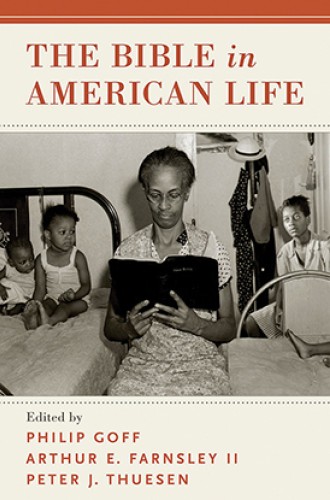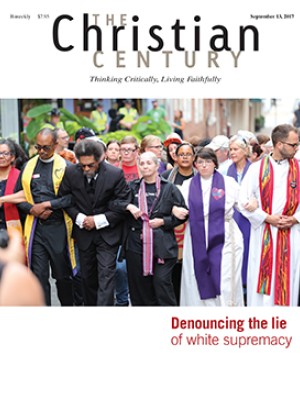The Bible's place in the American imagination
Scripture shapes culture—but always through what we bring to it.
King James is alive and well. The King James Version of the Bible, that is. In fact, it’s the most widely read translation in America. Although Zondervan’s NIV far surpassed the KJV in sales some time ago, 55 percent of people who’ve read the Bible outside of a worship service in the past year still prefer to read from the KJV, according to the studies analyzed in the introduction to a new book coedited by Philip Goff, Arthur E. Farnsley II, and Peter J. Thuesen.
In this impressive collection, 30 scholars contribute to an immense sociological review of who reads the Bible, how they read it, and how their reading has shaped American culture. The book begins with a summary of two national surveys (the 2012 General Social Survey and the National Congregation Study III), a thread that is referred to throughout the subsequent essays. The second section, “Past,” consists of 15 essays that explore the Bible’s use throughout American history, from the first Bible published in America (“the Indian Bible of 1663”) to the Bible’s influence on soul and pop music to the “commercial concerns” of the Bible industry. The reflections in these essays on how Americans have used the Bible serve as a stepping- stone to understanding why Americans use the Bible the way they do today.
Read our latest issue or browse back issues.
For instance, the “perspicuity of scripture”—the idea that the Bible is lucid and its meaning apparent—is nowhere more popular than in America. In his essay on interpretive authority and the rise of reference Bibles, B. M. Pietsch attributes the popularity of this idea to “sources as diverse as Reformation rhetoric of ‘the Bible alone,’ Common Sense epistemology, republican and revivalist ideas of religious authority, and frontier self-reliance.” Other essays in this volume, such as Emerson B. Powery’s review of “common sense” readings by white slaveholders, demonstrate how unwavering commitment to the idea of the Bible’s perspicuity can quickly become a prelude to very bad theology. These insights are significant for those who teach the Bible. Americans are still committed to common sense readings even though the complexities of scripture are time and again made known (see J. Derrick Lemons’s essay “Feels Right Exegesis”). Knowledge of how the Bible was read in the past will help pastors and teachers understand why our congregants or students are reading it the way they do today—and what we can do to help them read more faithfully.
The 11 essays comprising the third section, “Present,” consider a variety of questions regarding the uses of the Bible in America today. How are e-Bibles changing the way we read scripture? What effect does America’s increasingly diverse religious context have on how we teach the Bible? It is these essays, full of equally diligent and provocative research, that accomplish what the editors set out to do: to provide “a sustained, collaborative reflection on the ways Americans use the Bible in their personal lives.”
But the book moves beyond reflecting upon individual Americans’ reading habits and presses into the Bible’s social and national influence, as is evidenced in Mark Noll’s concluding essay. Noll keenly draws attention to the widespread clout the Bible has in America—from recent political speeches to city names. Clearly, the Bible still holds sway in the collective American imagination. Yet, according to Noll’s analysis, the thrust of this volume’s research indicates that “the major story about the Bible in American life unfolds in the private spaces, religious societies, and voluntary organizations where spiritual purposes dominate.” The evidence of the Bible’s influence in American culture is incontrovertible, but it all seems to start in the realm of personal devotion.
This book is academic in its presentation, but I find it particularly helpful as a new pastor stepping into my first full-time pastoral role. It challenges me to ask questions about how my congregants read and think about the Bible. For example, Daniel Silliman’s essay, “The Bible in the Evangelical Imagination,” reviews 33 popular evangelical fiction books. Silliman challenges me to wonder whether some of my congregants’ understandings of how to read the Bible are shaped more by fiction books than by sermons. Even more haunting, I wonder if my congregants will view me with the same deep skepticism of clergy that Silliman locates in many of the books he analyzes.
In addition to demonstrating how Americans interact with and think about the Bible, the essays in this collection show how biblical reading is moderated through the readers’ religious traditions and broader sociological descriptors. Such insights, if seriously considered, might lead Christians into deeper ecumenical conversations. Over the past few decades, such conversations have been widespread and their impact is being seen. For example, as Noll observes, “what seems to be taking place for a minority of Catholics is a somewhat more Protestant use of the Bible.” He explains that within the Catholic Church, institutions are “energetically” promoting Catholic engagement with the Bible outside of mass. “It is even possible,” Noll suggests—I imagine with some humor—“to find Catholics arguing among themselves about the acceptability of different Bible translations.” Such Protestant moves by Catholics are still a minority, but, as Noll observes, the moves are a result of post–Vatican II Catholic “involvement in wider society,” including ecumenical efforts “unimaginable fifty years ago.” The Bible in American Life claims to embody a “collaborative effort.” As such, it promises to spur on a collaborative ecclesial response.
Goff, Farnsley, and Thuesen have prepared a feast full of fat insights and sweet research. The questions they raise will enable pastors and professors to better prepare sermons and classes with an eye toward ecumenical dialogue. As the King James Version puts it, “Go your way, eat the fat, and drink the sweet, and send portions unto them for whom nothing is prepared” (Neh. 8:10).
A version of this article appears in the September 13 print edition under the title “Where the Bible has clout.”







